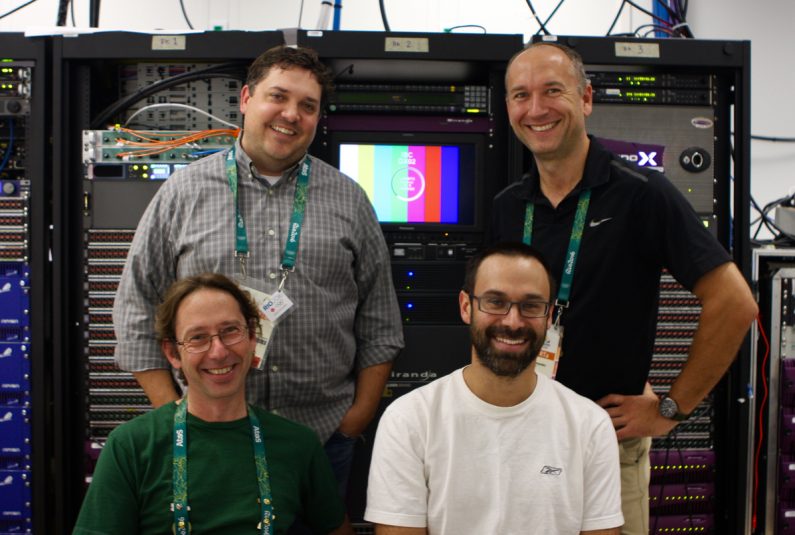Live From Rio 2016: CBC Ops in Rio, Toronto, Montreal United for Games
Entertaining Canadian viewers is always a dual-front effort: there are your French-language customers (watching on Radio-Canada) and your English-language customers (watching on CBC). That’s the chief reason the CBC/Radio-Canada is again relying heavily on its two major broadcast centers back home in Toronto and Montreal.

(Standing l-to-r) CBC’s Rob Bunn, Eric Milotzki and (seated l-to-r) Sylvain Archambault and Mathieu Rochon are making sure Canadians get their fill of Olympic action.
The CBC has taken at-home workflow to such an extreme that there are many circumstances – including out at a pair of onsite studios near Copacabana Beach (one for the R-C commentators, the other for the CBC commentators) — when the broadcaster completely bypasses the IBC and feeds directly to its broadcast centers in Canada.
“Once we [at the IBC] get up and running, we start to feel disconnected from [it] but feel very connected to home,” says Rob Bunn, technical producer, CBC. “We have a control point where we can check and make sure everything is working, but it all comes back to our backbone here and goes directly home.”
For Rio 2016, the CBC has connected its Toronto and Montreal studios directly with other so that they can share content and resources. The network is using an existing intercom matrix in Toronto and Montreal and not deploying a matrix at the IBC. So every RTS KP-32 panel is run and managed from Canada, with trunk master run between the two facilities there.
The two studios are not usually connected, and the connection will be taken down following the Games, although Bunn hopes that won’t always be the case.
“We are trying to become much more efficient together,” he says, “but we latched them up specifically for the Olympic project. Some day, that would be the dream, but we do things so differently that there’s hasn’t really been a need for it outside of Olympics.”
As for the onsite studio sets, the R-C team decided to go a little tech-heavy, using four cameras and an augmented-reality graphics system that allows the team to overlay graphics that remain stationary in the studio as the job camera moves about the space.
Onsite in Rio, the CBC has a crew of approximately 250 technical, production, and digital personnel to handle both language productions. Bunn acknowledges, though, that the ultimate goal is to leave as many staffers at home as possible.
“Our objective is to get more technical people at home,” Bunn explains, “so we can put more people gathering content on the ground here.”
One notable tech position that CBC attempted to keep at home but ultimately couldn’t was a video shader. To reroute those signals through home proved inefficient and impractical, so there is one video shader per shift shading both the CBC and R-C studios, as well as some of the venue cameras.
The live-broadcast day is a lengthy one for the Canadians with many of the eight channels available going live at 6 a.m. Rio time and staying on until 2 a.m. the next morning. CBC is also streaming all of its eight broadcast channels, in addition to Olympic Video Player app provided by the OBS that allows viewers to access any complete, live event going on at these Games.
As for the debate between live and pre-packaged content, CBC plays in a bit of both pools but ultimately prefers to be live whenever possible.
“I think the people at our organization are great at producing live as well as packaging something,” says Bunn. “Our market really demands it to be live. At Sochi we still had great numbers even in the middle of the night. We’re expecting the same for the PyeongChang [Winter Games in 2018]. We are great at, as we like to say “following the puck.”
